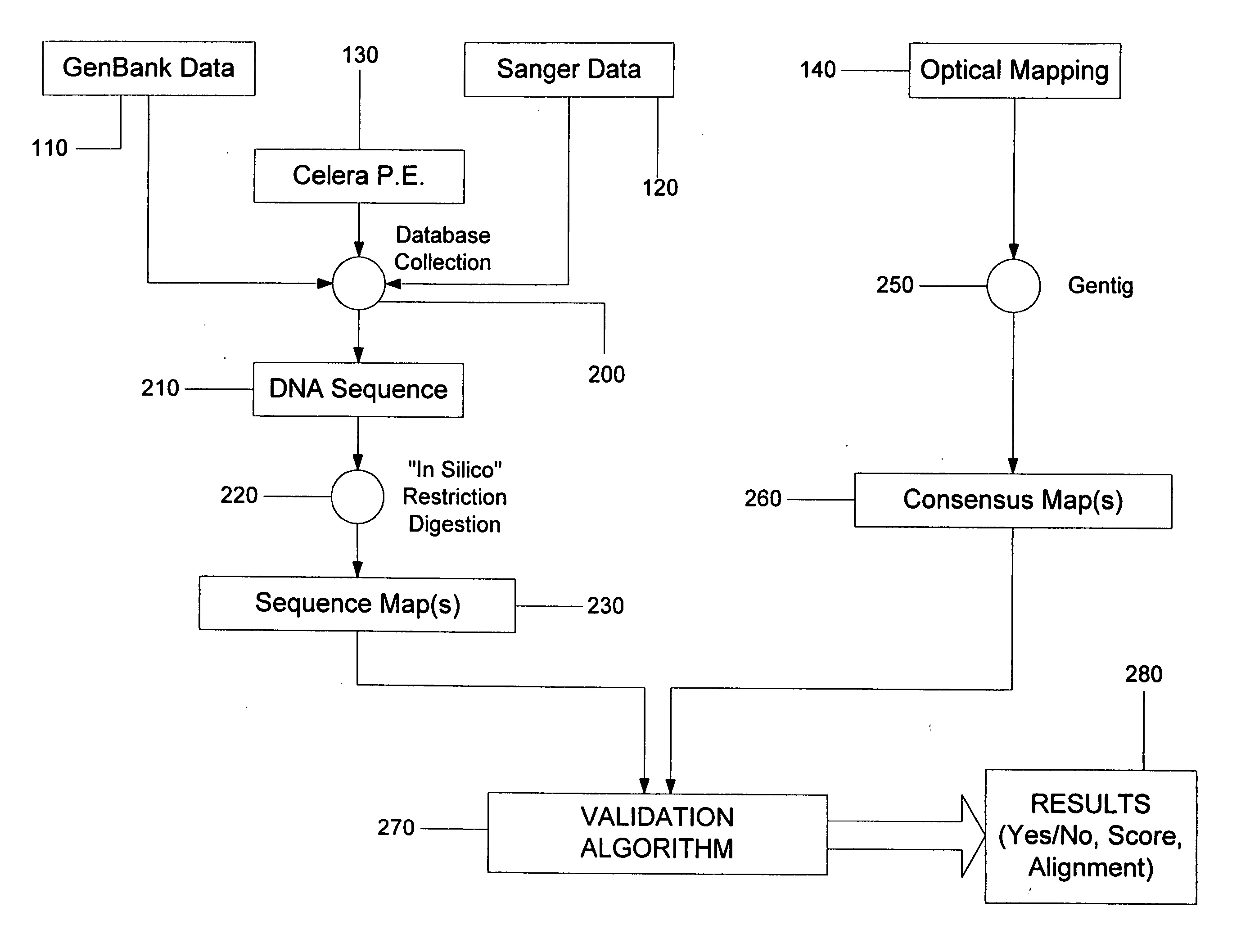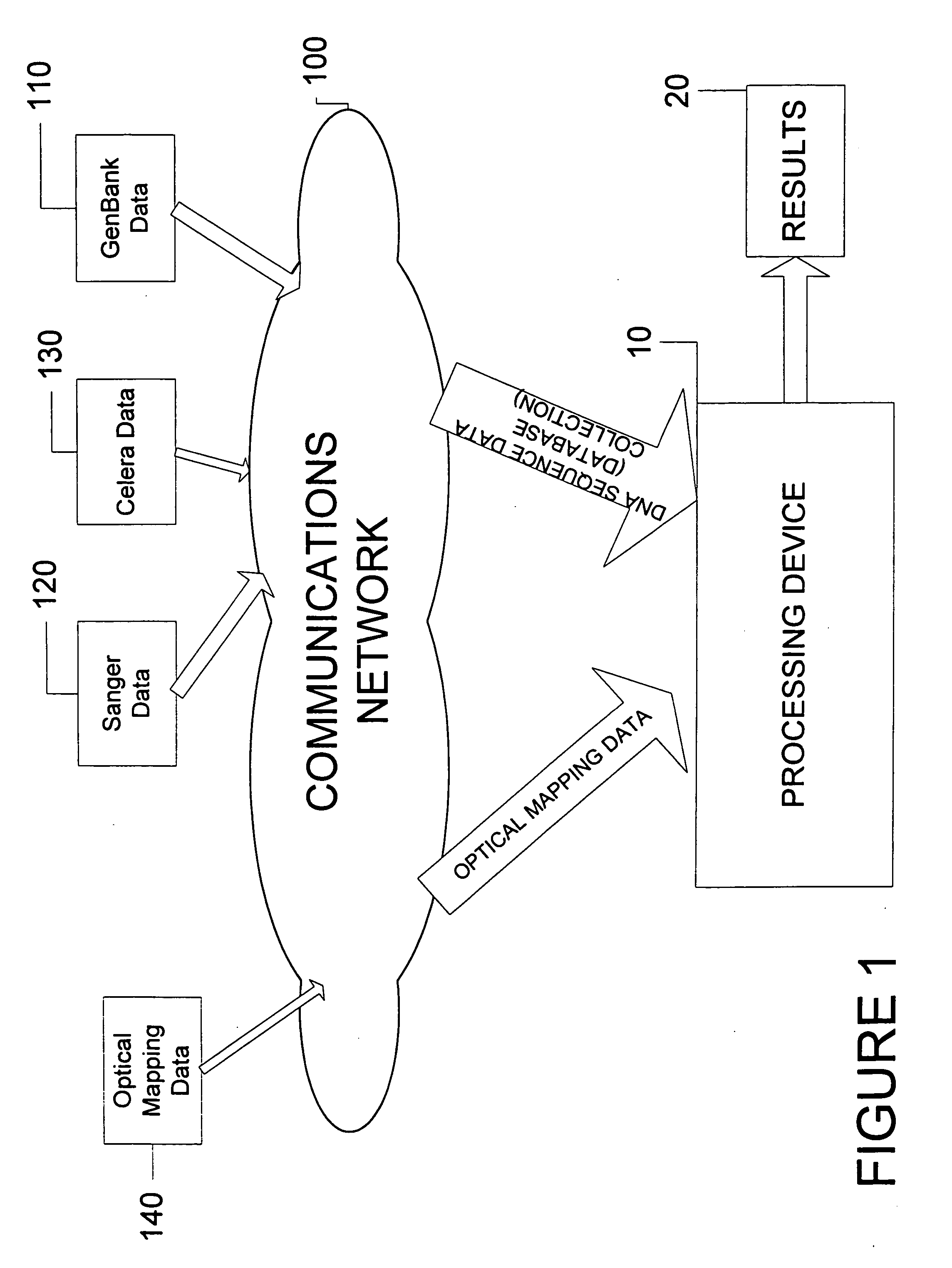System and process for validating, aligning and reordering one or more genetic sequence maps using at least one ordered restriction map
a technology of genetic sequence and sequence validation, applied in the field of system and process for sequence validation based on at least one ordered restriction map, can solve the problems of missing sections, limited nucleotide sequence data accuracy, and limited nucleotide sequence length
- Summary
- Abstract
- Description
- Claims
- Application Information
AI Technical Summary
Benefits of technology
Problems solved by technology
Method used
Image
Examples
example 3
[0088] No missing cuts and some false cuts. In this case and as shown in FIG. 6D, the converse case of Example 2 is being considered. A false cut event of the consensus map 640 can be modeled as a Bernoulli trial with probability pƒ. For example, the full term for such matching would likely aggregate fragments i and i−1 of the consensus map 640 against the j-th fragment of the sequence map 620. The full term would likely be: pc⨯12π(σi2+σ(i-1)2)ⅇ-((li+l(i-1))-aj)22(σi2+σ(i-1)2)⨯pf.
Taking the negative log likelihood again, the following expression is obtained: ln(2π(σi2+σ(i-1)2)pc)+((li+l(i-1))-aj)22(σi2+σ(i-1)2)+ln(1pf).
It should be noted that for the current data obtained from the optical mapping process, pƒ 10−5. This current data often dominate the complete expression.
example 4
[0089] Some missing cuts and some false cuts. Of course, it is conceivable that there may be missing cuts and false cuts together as shown in FIG. 6E. It is possible to accurately match or align the i−u cut in the sequence map 660 against the j−v cut in the consensus map 650. It is also possible to properly match the (i+1)-th cut (the cut immediately following the i-th fragment in both the consensus map 650 and the sequence map 660) in the two maps by appropriately treating all the intervening missing cuts in sequence map 660 and all the intervening false cuts in the consensus map 650. In this case, the “matching term” has the following general form: pc⨯12π(σi2+σ(i-1)2+…+σ(i-v)2)⨯ⅇ-(((li+l(i-1)+…+l(i-v))-(aj+a(j-1)+…+a(j-u)))22(σi2+σ(i-1)2+…+σ(i-v)2))⨯(1-pc)(u-1)⨯pf(v-1).
Taking the negative log likelihood, the following expression is obtained: -ln pc+ln(2π(σi2+σ(i-1)2+…+σ(i-v)2))+((li+l(i-1)+…+l(i-v))-(aj+a(j-1)+…+a(j-u)))22(σi2+σ(i-1)2+…+σ(i-v)2)+(u-1)ln11-pc+(v-1)ln...
example 1
[0111] Extending α0 by x leads to a match. If α0 is “extended” by an extra size x (as shown in FIG. 6F), x is extended as far to the left as possible to match the cut on the left of fragments i−n (e.g., fragment of size li−2 illustrated in FIG. 6F).
[0112] The value of this match (which is built on top of the derivation performed for the “regular case”) is provided by the following expression: ln(2π(σ(i-n)2+σ(i-(n-1))2+…+σi2)pc)+((l(i-n)+l(i-(n-1))+…+li)-(x+a0+a1+…+aj))22(σ(i-n)2+σ(i-(n-1))2+…+σi2)+xL+(n-1) ln1pf+j ln11-pc.
[0113] This case express depends on two parameters which did not appear in the regular case: [0114] x being the size extension (please note it in the second and the third term), and [0115] L being the molecule map average fragment size.
[0116] The second sub-term is preferably the regular “sizing error” penalty which takes into account the extension x. The third sub-term may add an extra penalty based on the amount of the end fragment being stretched wi...
PUM
| Property | Measurement | Unit |
|---|---|---|
| Length | aaaaa | aaaaa |
| Size | aaaaa | aaaaa |
| Density | aaaaa | aaaaa |
Abstract
Description
Claims
Application Information
 Login to View More
Login to View More - R&D
- Intellectual Property
- Life Sciences
- Materials
- Tech Scout
- Unparalleled Data Quality
- Higher Quality Content
- 60% Fewer Hallucinations
Browse by: Latest US Patents, China's latest patents, Technical Efficacy Thesaurus, Application Domain, Technology Topic, Popular Technical Reports.
© 2025 PatSnap. All rights reserved.Legal|Privacy policy|Modern Slavery Act Transparency Statement|Sitemap|About US| Contact US: help@patsnap.com



